The first and most important thing you need to know about Apple AirPods 4 is that there are two types of them: with and without noise cancellation. Moreover, they differ not only in this option; the manufacturer tried to better differentiate the budget and more expensive modifications in several parameters. Apple AirPods 4 with noise reduction also has a Find My function, when the iPhone can determine the location of the case on a map, and the case itself supports not only wired charging, but also wireless charging using both a MagSafe charger and any other Qi standard. Prices for AirPods 4 without noise cancellation start at about 20 thousand rubles, for AirPods 4 with noise cancellation – from 23 thousand.
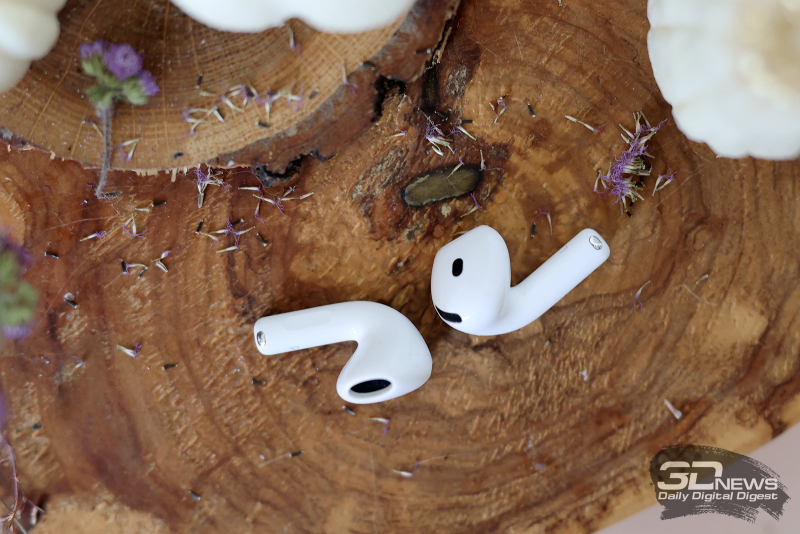
The first AirPods came out seven years ago – it’s scary to imagine! But since then, not much has changed, except for the fact that wired headphones are completely a thing of the past, and TWS headphones (launched to the masses by Apple) have become the absolute mainstream, and literally everyone is producing them. Except that in-ear plugs turned out to be much more popular than earbuds. And yet, “regular” AirPods (not Pro) are necessarily earbuds (a legacy of the legendary EarPods). They didn’t change much from generation to generation – the sound gradually improved, the case got smaller, and some interesting features appeared, like voicing notifications using Siri. And then in the fourth generation something more interesting and radical happened than usual.
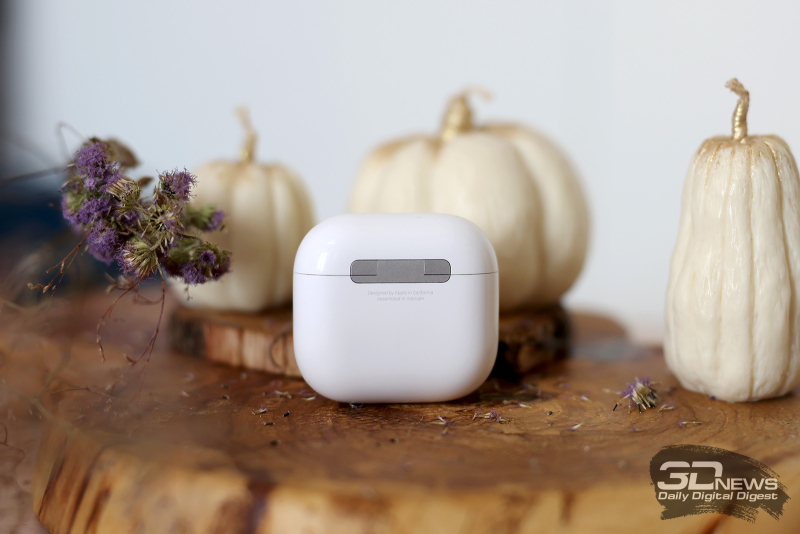
In fact, noise-canceling earbuds are not unique. Suffice it to recall the same HUAWEI FreeBuds 3/4/5 – yes, yes, HUAWEI open headphones have had noise reduction for three generations in a row. But when Apple does something, it immediately attracts attention, especially since there was hope that the Cupertino team would be able to do it especially well. In addition, they talked a lot about the fit of their new model, based on data obtained from 50 (!) million ears. Considering my individual intolerance to earbuds (none of them stay in my ears well enough), I was doubly curious to check. Well, let’s satisfy this curiosity.
⇡#Design and construction
Apple AirPods 4 are placed in a very small square case – it has not changed compared to the previous version. In general, this is a classic for almost any current TWS headphones: white plastic, rounded edges and corners, inside there are pockets with magnets. On the front there is a charging indicator.
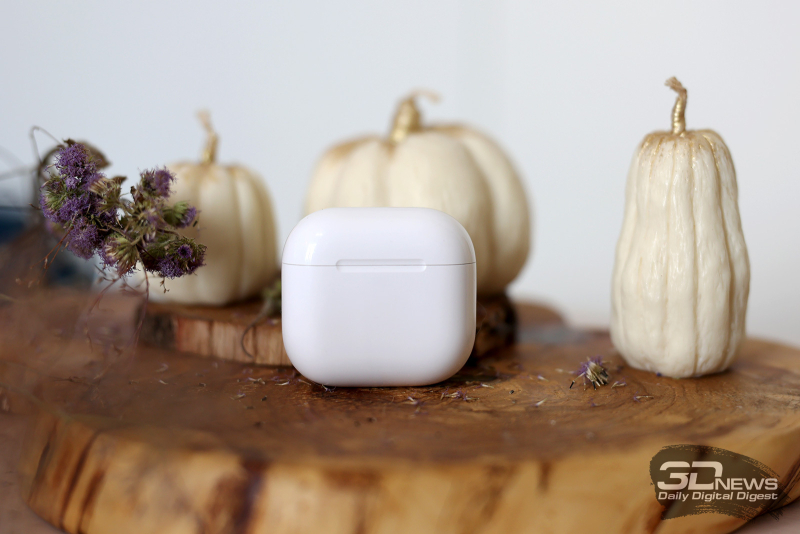
In fact, the only thing that sets the AirPods 4 case apart from many competitors is the speakers located on the bottom edge (yes, there are several of them at once – we see three holes on one side of the USB Type-C port and one on the other). You can, conditionally, “call” the case in search.
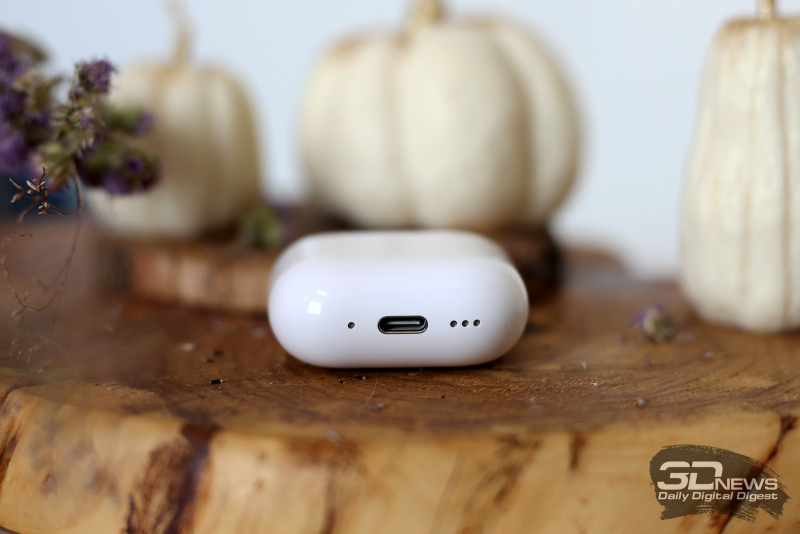
The lid of the case is equipped with a closer, it opens and closes easily, but the hinge is a little loose. From headphones that cost more than 20 thousand rubles, you still expect higher quality performance. But the case is really small and light – 34.7 grams (32.3 grams in the version without noise reduction), it is perhaps the most compact compared to its competitors.

The headphones themselves have hardly changed for many years. A small leg with contacts for mounting in a case and charging, as well as a microphone, a large head with large grilles, under which both the speakers and the microphone for noise reduction are hidden. Another microphone for these purposes is at the top of the legs.
We also note the presence of a touch control zone – it is emphasized by a small indentation on the inside of the legs.
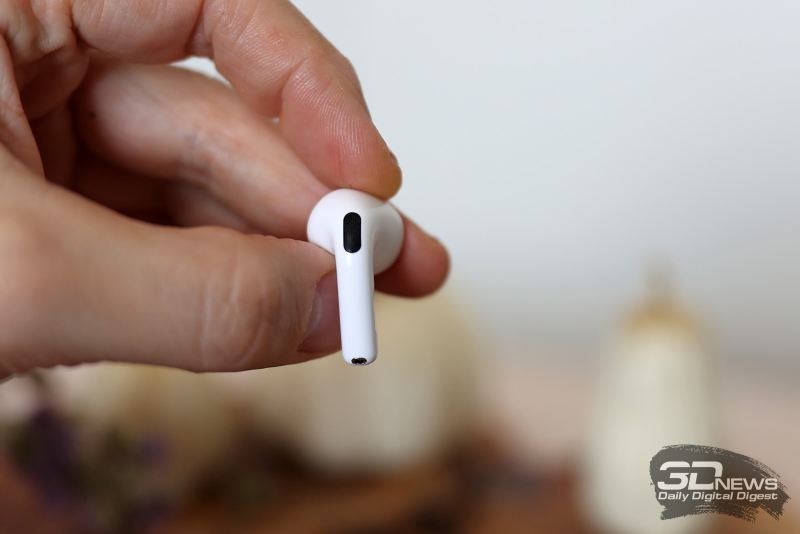
There are no questions about the quality of the headphones – the materials are the same, but nothing creaks. Each earbud weighs 4.3 grams. They are protected from moisture according to the IP54 standard – you should not swim in them, but you can walk in the rain, as well as drop them in the sand.
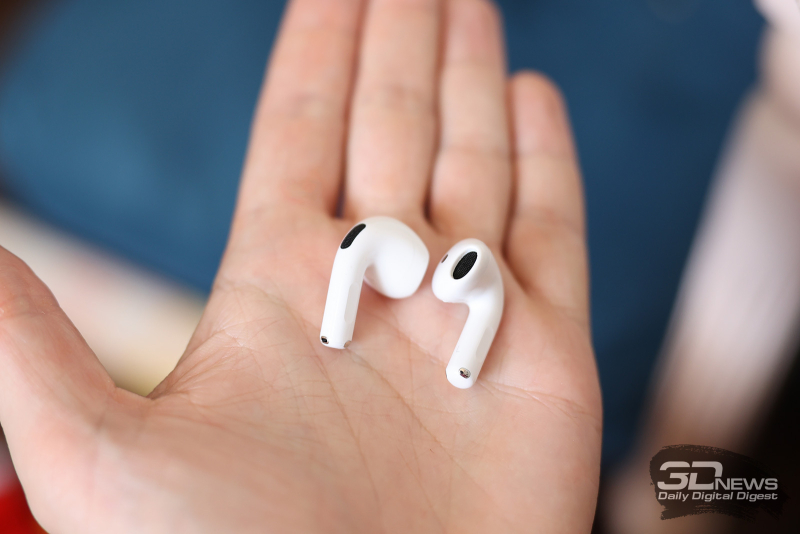
Now about convenience. As I already said, the earbuds usually don’t fit me at all – they fall out of my ears even during normal walking, or at least cause discomfort. I can’t say that AirPods 4 changed my attitude towards open, compact headphones, but it seems that Apple really studied the shape of a huge number of ears, and among them there were ones similar to mine. These are, perhaps, the most comfortable earbuds that I have tried before – the only inconvenience I can mention is the need to occasionally adjust them in the ear when walking, which is a great achievement for me. But there is still no talk about playing sports – here you need either full-size or in-ear headphones, with no options. Although, of course, if earbuds from previous generations or other brands suit you, then AirPods 4 will seem very comfortable, without a doubt. I will note that they do not rub at all and are not particularly felt in the ear at all; the design is really very successful.
⇡#Binding, control, functionality
Perhaps the most impressive thing about any AirPods is their integration into the operating system of the host device (usually an iPhone, but the interaction with iPad/Mac is perfectly fine). Actually, the ecosystem with the perfect integration of individual devices into it is the key reason for choosing Apple technology (after marketing, of course). And it’s clear why.
To pair your headphones with your smartphone, you don’t need to do almost anything: you open the case with AirPods 4 and they are already recognized by any nearby Apple device. A separate tab appears in the settings (no additional applications need to be installed), and some parameters can be changed in the volume control menu (it also changes). All this continues to amaze us from year to year – we seem to have gotten used to it a long time ago, but neither Samsung, nor HUAWEI, nor anyone else can replicate such seamless integration with their own accessories.
As for the available settings, for AirPods 4 with noise reduction this noise reduction is available, which can be either turned on/off or activated in the transparency mode, in which the headphones will, on the contrary, amplify external sounds. There is also an adaptive mode, when the headphones themselves decide what to do with noise reduction/transparency. I would trust him only with great caution – they recognize when it is necessary to muffle external noise, and when, on the contrary, to emphasize, they make mistakes.
But there are also really interesting, working features. For example, the headset lowers the volume and turns on the same transparency mode when you start talking – this option, however, must be activated in the settings. This just works great. As well as adjusting the volume depending on the surrounding environment – AirPods 4 support it at a sufficient level.
Control is available using the touch surface (single press – answer the call/pause or resume playback, double press – end the call, scroll to the next song, three times – scroll to the previous song, holding the earphone stem – changing the noise reduction settings). Of course, playback stops as soon as you remove the headphones from your ears – even the most budget models can do such things. But what they don’t know how to do is respond to head movements: in AirPods, you can nod if you confirm the answer to a call, and shake your head if you reject the call.
However, you cannot adjust the volume directly on the headphones – such a precious option is left exclusive to the AirPods Pro series. After all, Apple is the king of restrictions, sometimes the most ridiculous ones.

Siri is also seriously integrated – you can also respond to her questions with head movements, and she can also report notifications and even read messages from instant messengers, but for some reason very selectively (some of them read out, some of them don’t, more confusing than helpful – unreliable narrator).
I already wrote about the Find My function above – here, as with AirTag, the location of the case is marked on the map. You can also “call” the case to clarify its position within the room.
⇡#Sound quality, noise reduction, battery life
The most important question for AirPods 4 is, of course, “how is the noise reduction?” In short, slightly better than average. Of course, it is impossible to achieve ideal noise reduction without sound insulation as on closed models, but Apple headphones have some problems associated not only with the cups not being tightly immersed in the ear canals. The headset really cuts out most of the noise – for example, you can listen to music in the same room with a person who is watching TV at high volume. But some overtones will inevitably invade the sound picture – usually associated with mid-frequency or high-frequency noise. Moreover, with a tighter fit, noise can “fly in” even more than with a large gap – it feels like it’s hard for the noise reduction system.
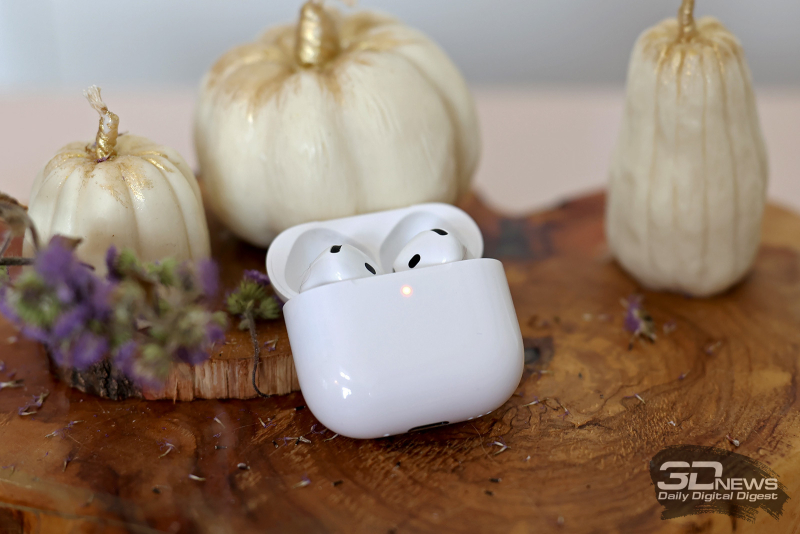
But this is “slightly better than average” when compared with the general market level – for open headphones everything is very good. With AirPods 4, you can listen to not only loud music in transport, but also podcasts and audiobooks. Yes, background noise is inevitable, but the headphones will be able to overcome it even at less than maximum volume.
As for microphones related not to noise reduction, but to conversations, there is nothing to complain about – the quality of voice transmission is good and external noise is cut off completely correctly.
On the acoustic design – Apple, as usual, does not provide technical details about the speakers used and their acoustic characteristics. Therefore, we evaluate sound quality without relying on characteristics.
To evaluate the sound quality of acoustic devices, we use the FSQ method. In its standard version, it includes 14 test tracks, with the help of which the following characteristics of the speaker system are assessed:
- Sound path margin for undistorted loudness level;
- Correct phasing of audio equipment;
- Presence of extraneous overtones, noise and interference in the sound path;
- The ability of the sound path to reproduce the lowest sound frequencies;
- Uneven frequency response of the sound path;
- Linearity of the stereo picture across the width of the sound stage;
- Microdynamics and depth separation of the soundstage;
- Position and focusing of the stereo picture in the horizontal and vertical planes and the naturalness of the transmission of the musical attack;
- Musical and timbre balance of sound of musical instruments and vocals;
- The linearity of the sound picture in terms of loudness and macrodynamics.
Those wishing to test their own audio system or headphones are advised to download the “Audio Doctor FSQ” test disc and testing instructions from the MTUSI Acoustic Center page. One of the advantages of this method is clear evaluation criteria that compensate for the subjective nature of testing. In many tests, the expert only needs to answer whether the sounds that should be in the recording are heard, or, conversely, those that should not be there.
Next, we will sequentially list the results of listening to FSQ test recordings on Apple AirPods 4. Each test will be accompanied by a brief description from the instructions for “FSQ Audio Doctor”. Testing was carried out in conjunction with an iPhone 13 Pro Max smartphone with noise reduction turned on (this is the basic way to use headphones, noise reduction is turned on by default).
The test results are confirmed by general subjective sensations. The Apple AirPods 4 don’t have any significant sound problems – they sound very rich for earbuds. Yes, low frequencies are artificially “highlighted” from the general background, which is why they prevail in the sound balance, especially if you place the headphones as closely as possible to the ear canal, but this is justified, because otherwise, if the fit is loose, the balance between low and high frequencies will not be maintained. And so it holds up well. At the same time, the natural depth of the bass is not enough, as can be seen from testing – in this case, the headphones are focused on volume, not depth. There are no problems with mids and high frequencies – we are not talking about the hi-end level, but for mainstream headphones the AirPods 4 sound good. At the same time, noise reduction has almost no effect on the sound, without creating “impurities” in the sound.
It’s worth mentioning the “spatial audio” playback system – a virtual surround sound is created, which in the database slightly adds color to the music (but in fact is almost unnoticeable), but in the Apple Music library there are tracks with support for “spatial audio”, and they sound just right quite impressive. In fact, AirPods 4 have no problems with the scene.
As for autonomy, with noise cancellation the headphones last about 4 hours, without noise cancellation – about 6 hours. We confirm what is stated by the manufacturer. A fully charged case is enough for 5 headphone charging cycles (that is, 20 hours with noise cancellation, 30 hours without noise cancellation). Quite a decent level. I already talked about charging above – both wired (here the usual port is USB Type-C) and wireless are possible.
⇡#Conclusion
The situation with Apple AirPods is always quite simple – and in the fourth version, even despite the noise reduction that has appeared (not the most effective, but it really works), it does not change much. These are definitely the best “budget” headphones for iPhone owners – simply due to the impressive integration between the devices, unattainable from any other brands. And here neither the sound quality (although it is definitely good), nor the convenience (for my taste, the best among earbuds), nor the noise reduction (very decent for this headphone format) is important.
At the same time, AirPods 4 are frankly overpriced – competing models with similar (or even better) sound quality and noise reduction (there are also open models) cost one and a half to two times cheaper. And for owners of Android smartphones, they are preferable without any buts – in terms of characteristics not related to interaction with a smartphone, AirPods 4 either do not have an advantage, or it is not so significant. It is also always sad that there is no relatively inexpensive model with a closed design – you have to add another 3 to 6 thousand for Pro 2 (they also surpass AirPods 4 in sound and provide better noise cancellation). But okay – it’s just a matter of taste.
In any case, you can notice that when evaluating headphones (like any Apple technology, in fact), we are talking about positioning, price, and some other abstract things, and not about the pure quality of performance. It’s good, but not outstanding – and it’s impossible to perceive AirPods 4 as “just decent headphones for in-ear lovers” and not a basic accessory for users of numerous Apple devices (which have become much better).
We thank the BigGeek store for providing the Apple AirPods 4 headphones for testing.